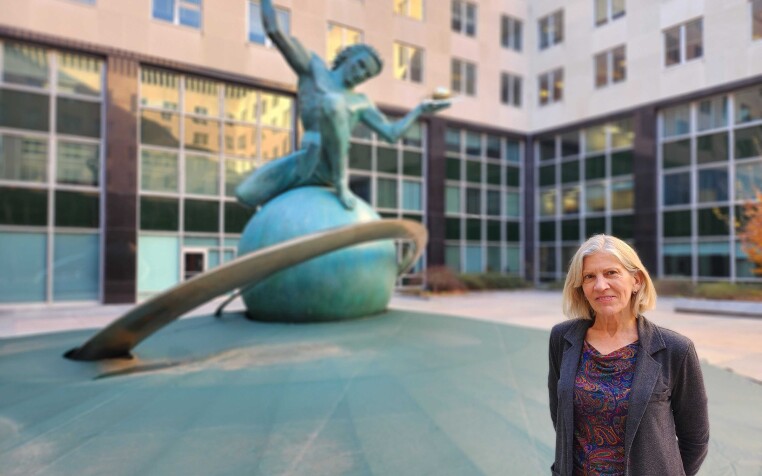New Chief S&T Adviser at State Department Looks to Expand Cadre of Tech-Savvy Diplomats

Patricia Gruber stands in a courtyard at the State Department next to a sculpture called the Expanding Universe Fountain.
(Lindsay McKenzie / FYI)
Maritime technologist Patricia Gruber began a three-year term as the top science and technology adviser in the State Department in September. In addition to advising the secretary of state, she is tasked with promoting international S&T cooperation and deepening the department’s own technical expertise.
“I would say it’s going very well, but it’s a steep learning curve,” Gruber reflected during an interview with FYI in December.
“What I didn’t realize about the State Department before I got here is there’s S&T going on everywhere,” she said. “Pretty much every bureau in every office has some level of science and technology capacity already [...] everything from arms control, energy, food security, global health, environmental issues, financial technologies — I mean, the list just goes on and on.”
“The part I didn’t really recognize before I took the job is a lot of it is really focused on collaborating and just looking across the department and understanding where maybe connections need to be made, and that sort of thing. Another piece of my remit, though, is also to be the link between U.S. academia and the department,” she added.
Gruber previously served as the technical director for the Office of Naval Research’s global engagement arm for six years and before that was a maritime systems executive at Battelle and deputy director of the Applied Research Laboratory at Penn State University. She holds a doctorate in applied marine physics from the University of Miami.
Though Gruber is the first official appointee to the chief S&T adviser role at the State Department in three years, she said the role has been “far from vacant.” She praised the work of her predecessor, Allison Schwier, who served as acting S&T adviser from the beginning of the Biden administration and is now Gruber’s deputy. Her office is typically staffed with eight to ten employees and collaborates with other S&T-focused units in the department, such as the Office of the Special Envoy for Critical and Emerging Technology established
A focus of Gruber’s portfolio is to connect the department with technical experts domestically and abroad.
One way that Gruber plans to do so is by increasing the number of regional technology officers (RTOs) that the U.S. stations across the world. There are currently RTOs in six locations — Tokyo, Sydney, Brussels, Berlin, London, and São Paulo — but she said the department plans to expand the total number of RTOs to more than a dozen, in line with recent direction
The RTO program launched in 2021 and is already playing an important role in building relationships with industry partners in each region, according to Gruber.
“Their job is to energize the S&T ecosystem in the region. So they’re not bilateral, they have multiple countries [of responsibility],” she explained.
For example, the Tokyo and Sydney-based RTOs are involved in building the multilateral partnership between Japan, India, Australia, and the U.S. known as the “Quad,” Gruber said. The London RTO helped to coordinate the AI Safety Summit that Vice President Kamala Harris attended during her visit to the UK in November 2023.
“[The RTOs] tend to engage, I would say, less with academia but more with industry and small and medium sized businesses in particular that are doing innovative things,” she added
In addition to engaging with business leaders in their region, RTOs serve as a resource for their department colleagues, building internal technological expertise through trainings and raising awareness of emerging technology issues. The rationale for the RTO program was informed by
Gruber said growing the RTO program is “going to take some effort,” as she plans to expand it to regions where “our relationships aren’t as well established.” She particularly wants to build stronger relationships with African countries. Gruber plans to visit Morocco later this month to attend the National Academies’ second U.S.-Africa Frontiers of Science, Engineering and Medicine Symposium.
Beyond the RTO program, Gruber said she views fellowship programs that bring scientists and engineers to work in the State Department as central to building its STEM expertise, noting she regularly runs into alumni from them. The programs include the Jefferson Science Fellowship and fellowships sponsored by the American Institute of Physics, American Association for the Advancement of Science, Institute of Electrical and Electronics Engineers, and most recently
Offering examples of technology areas that are a focus of her attention, Gruber identified semiconductors and artificial intelligence, as the government works to keep up with advances in technologies such as ChatGPT and build national capacity for semiconductor manufacturing through the implementation of the CHIPS and Science Act.
Gruber also commented on the balance between increasing international research collaboration against the need to protect U.S. research security, saying it is no easy feat but that she remains optimistic about the potential for the U.S. to build meaningful research partnerships, even where there are diplomatic challenges. Gruber noted for example that the U.S. is actively negotiating with China to renew the countries’ stalled science and technology cooperation agreement,
“Science diplomacy is a wonderful tool to build partnerships — mutually beneficial partnerships — that are non-confrontational,” Gruber said. “We’re all working toward goals to build a better society and solve global problems like climate change, food security, that sort of thing. So science and technology is an invaluable tool for diplomacy and foreign affairs.”


